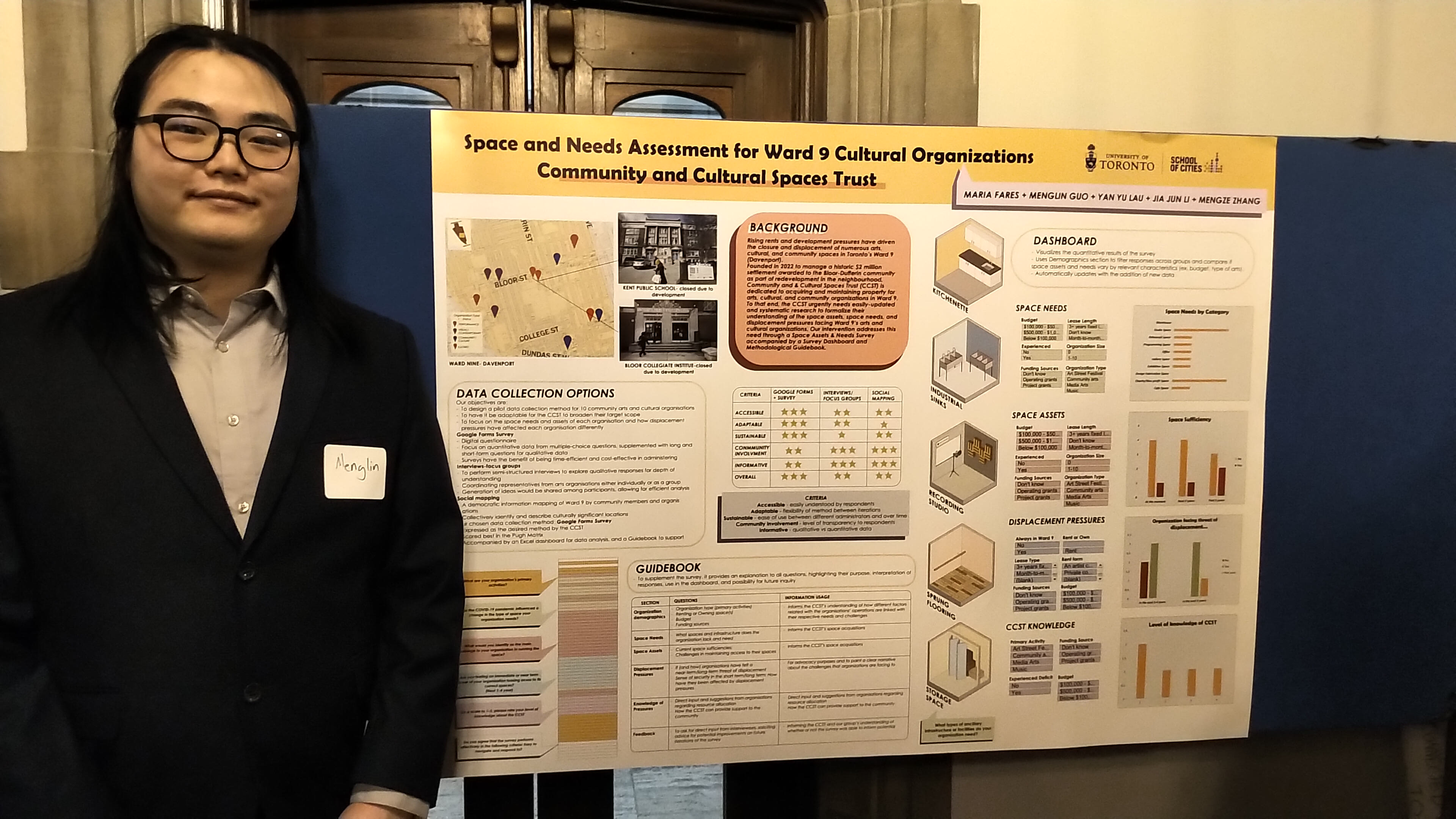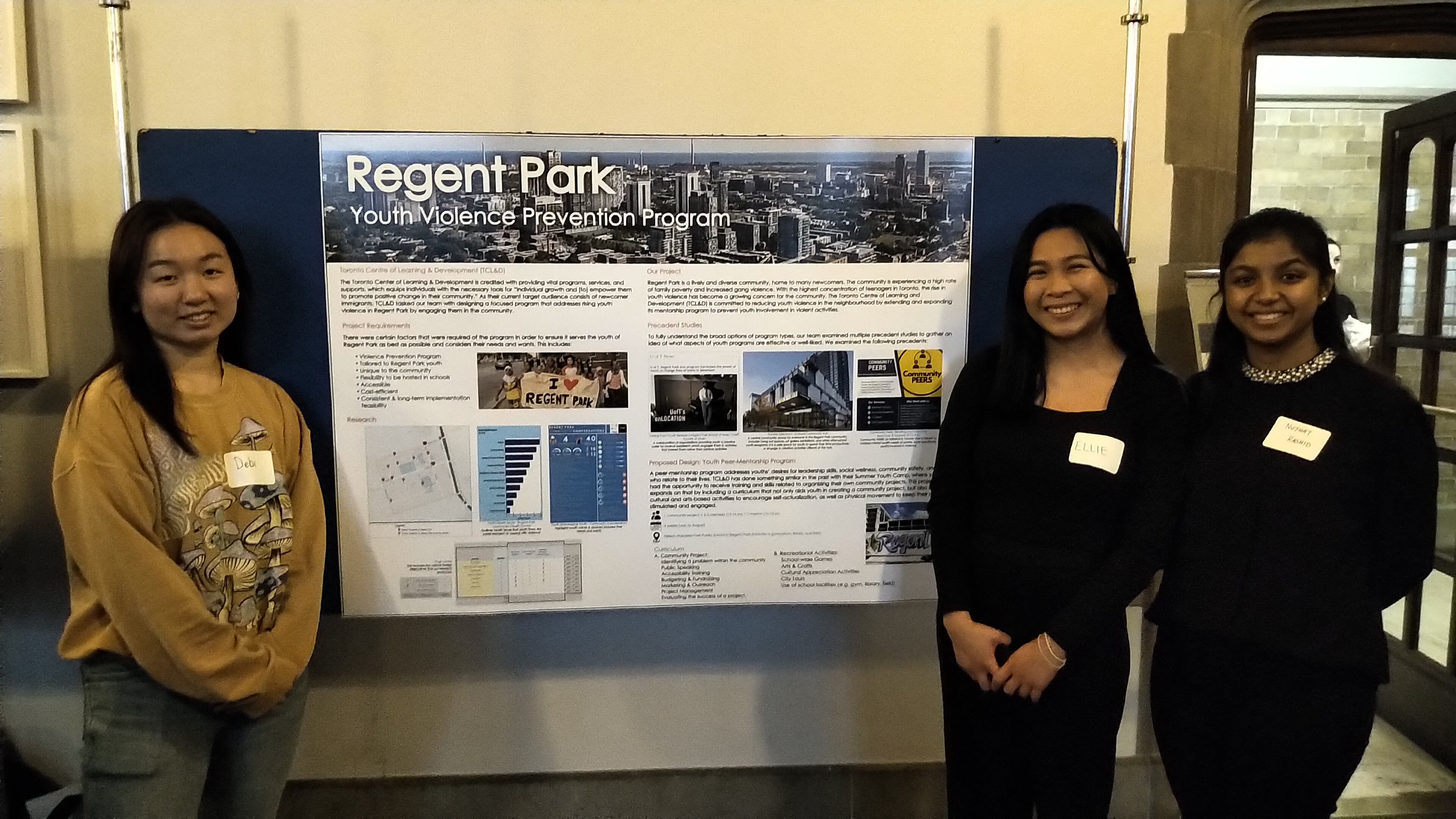Over this past year, 94 undergraduate students from across U of T’s campuses and faculties have been working with community partners throughout Canada, the United States, and India to address our most pressing urban challenges. In March, School of Cities and Urban Studies held a Community Exhibition where student groups were able to share their work with peers, faculty, and members of the community.
We had an opportunity to chat with two of our participating CIRHR undergraduate students, Ellie Ho Huang, whose team project focused on youth violence prevention in Regent Park, and Menglin Guo, whose team project focused on space needs and displacement facing Ward 9’s arts and cultural organizations. Check out our full interview below to learn more about their respective projects, and what they’ve gleaned from the process of researching and developing their proposed solutions.
 Can you tell me a little bit about your project? What key issue was your team looking to resolve/support and what was your proposed solution?
Can you tell me a little bit about your project? What key issue was your team looking to resolve/support and what was your proposed solution?
E: The Toronto Center of Learning & Development’s (TCL&D) target audience mainly consists of newcomer immigrants, so our team was tasked with engaging newcomers in Regent Park, a lively and diverse community with a high rate of family poverty and increased gang violence, to then design a program that addresses rising youth violence in the area. Regent Park has the highest concentration of teenagers in Toronto, making the escalation in youth violence a growing concern for the community. Any proposed solution needed to be tailored to Regent Park youth and community, flexible in its location delivery, accessible, and cost-efficient with long-term implementation feasibility.
Our research, then, led to our proposal of a Peer-Mentorship program, which addresses youths’ desires for leadership skills, social wellness, and community safety, all led by staff who relate to their lived experiences. TCL&D previously ran a similar Youth Summer Camp program where youth had the opportunity to receive training and skills related to organizing their own community projects. Our design solution expands upon that work by including cultural and arts-based activities to encourage self-actualization, and physical movement to keep their minds stimulated and engaged.
M: The Community and Cultural Spaces Trust (CCST) is dedicated to acquiring and maintaining property for arts, cultural, and community organizations in Ward 9 (Davenport). To that end, the CCST urgently needs easily-updated and systematic research to formalize their understanding of the space assets, space needs, and displacement pressures facing Ward 9’s arts and cultural organizations.
With our creation of a Space Assets & Needs Survey, accompanied by a Survey Dashboard and Methodological Guidebook, we set out to design a solution that’s unbiased and informative, accessible to the community and receptive to community input, and easy to modify and maintain in the future. Using the guidebook, the CCST will be able to adjust the survey and dashboard to meet evolving data collection needs and build a more secure future for the arts and cultural community in Ward 9.
Why did you choose this particular subject, and why is it particularly urgent/relevant now?
E: I wanted to work with vulnerable youth and help them deal with trauma, specifically related to crime. The topic of crime and its impact on young adults is a topic that is very close to me, as I grew up in the Dominican Republic where crime was also an issue. I found that my own experiences allowed me to bring an empathetic perspective to my role, which helped me to understand the severity of the challenges faced by the youth we’re hoping to help.
M: Rising rents and development pressures have driven the closure and displacement of numerous arts, cultural, and community spaces in Toronto’s Ward 9 and Toronto widely. Founded in 2022 to manage a historic $2 million settlement awarded to the Bloor-Dufferin community as part of redevelopment in the neighbourhood, the CCST is positioned to begin urgently addressing these challenges now.

Can you talk about what you gleaned from the process of building this project with your teammates?
E: As a social sciences student, I honed my research skills predominately through academic exercises. Participating in this project gave me an invaluable opportunity to apply my research abilities to real-world issues and affect tangible change. Engaging with key stakeholders within the community, particularly those deeply involved with youth, allowed me to foster a deeper connection with the community and ignited a passion for further involvement and advocacy.
Working on this project has also helped me understand the systemic effects of crime, the importance of support and guidance when young adults are coming of age, and how to better advocate for policy and analyze existing policies in need of change. Moreover, I have learned how to design programs and curricula that provide resources, guidance, and opportunities to help others cope with the effects of crime. Moving forward, I’m inspired to continue working for the betterment of such communities, and given the chance, I am eager to collaborate with the Toronto Centre of Learning and Development to actualize the program I helped design.
M: I’ve gleaned a great deal from this project, building on the “best practices” we’ve learned in the IRHR program. When conducting research, there’s a level of professionalism required, and a need to minimize bias to strengthen validity. However, when working with vulnerable groups – especially as a group of students who invested one year in a project that will be a long-term effort – I learned about the importance of being relational, rather than transactional, in order to build trust.
Being able to work with my colleagues from the urban studies, architecture, and information studies departments was also invaluable, as we all had different skillsets and perspectives informed by our different academic backgrounds. Working in a multidisciplinary group gave me a chance to work on communication, and to open my mind to new viewpoints and solutions, in the moment and in future collaborations.
Talk to me about the future – what are your research and/or career aspirations?
E: I have a strong interest in Human Resources. Nevertheless, my dedication to mental health persists, so I aim to actively seek out volunteer opportunities in the mental health field while also pursuing a professional career in HR.
M: What I am looking forward to in the future is being able to build on this experience. I hope to produce meaningful work in sustainable urban development and community engagement, working on projects that improve our communities.


